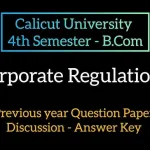MS University offers a wide range of courses, and preparing for the exams involves understanding the previous year’s questions to improve performance. Below are key questions and answers from various subjects that will help students prepare thoroughly. The questions provided cover multiple disciplines, giving insights into what has been asked in the past and what can be expected in future exams.
Economics
Question: What is the difference between microeconomics and macroeconomics?
Answer: Microeconomics deals with individual and business-level decisions, while macroeconomics focuses on the economy as a whole, including inflation, growth, and employment.
Question: Explain the concept of elasticity of demand.
Answer: Elasticity of demand measures how the quantity demanded of a good changes in response to a change in its price.
Question: Define opportunity cost with an example.
Answer: Opportunity cost refers to the value of the next best alternative forgone when making a choice, such as choosing between buying a book or watching a movie.
Question: What is meant by a monopoly market?
Answer: A monopoly market is one where a single seller controls the entire supply of a product or service, without any close substitutes.
Question: How does inflation affect the purchasing power of money?
Answer: Inflation erodes the purchasing power of money, meaning that over time, the same amount of money buys fewer goods and services.
Question: Explain the law of supply.
Answer: The law of supply states that, ceteris paribus, the quantity supplied of a good rises as the price of the good rises.
Question: What are the different types of unemployment?
Answer: Types of unemployment include frictional, structural, cyclical, and seasonal unemployment.
Question: Define Gross Domestic Product (GDP).
Answer: GDP is the total monetary value of all goods and services produced within a country’s borders in a specific time period.
Question: What is the relationship between interest rates and investment?
Answer: Generally, as interest rates decrease, investment increases because borrowing costs are lower, making it cheaper to finance new projects.
Question: Explain the concept of consumer surplus.
Answer: Consumer surplus is the difference between what consumers are willing to pay for a good or service and what they actually pay.
Question: How is national income calculated?
Answer: National income is calculated as the total of all income earned by residents of a country, including wages, profits, rent, and interest.
Question: What is fiscal policy?
Answer: Fiscal policy refers to government actions regarding taxation and spending to influence the economy.
Question: What are the main objectives of monetary policy?
Answer: The main objectives of monetary policy are to control inflation, manage employment levels, and stabilize the currency.
Question: How does an open economy differ from a closed economy?
Answer: An open economy engages in international trade, while a closed economy does not interact with other countries’ economies.
Question: What is the difference between nominal and real GDP?
Answer: Nominal GDP is measured at current prices, while real GDP is adjusted for inflation to reflect the actual value of goods and services.
Question: Explain the term ‘invisible hand’ in economics.
Answer: The invisible hand is a metaphor introduced by Adam Smith, suggesting that individual self-interest unintentionally promotes the well-being of society.
Question: What is the role of central banks in an economy?
Answer: Central banks regulate the money supply, control inflation, and act as lenders of last resort.
Question: Describe the term ‘business cycle.’
Answer: The business cycle refers to the fluctuations in economic activity, including periods of expansion, peak, contraction, and trough.
Question: What is meant by the term ‘balance of payments’?
Answer: The balance of payments records all economic transactions between residents of a country and the rest of the world.
Accounting
Question: What is the accounting equation?
Answer: The accounting equation is Assets = Liabilities + Equity, which is the foundation of double-entry bookkeeping.
Question: Define accrual accounting.
Answer: Accrual accounting records revenues and expenses when they are earned or incurred, regardless of when the cash is received or paid.
Question: What is depreciation, and why is it important?
Answer: Depreciation is the allocation of the cost of a tangible asset over its useful life, helping businesses match costs with revenues.
Question: Explain the difference between a balance sheet and an income statement.
Answer: A balance sheet shows a company’s financial position at a specific point in time, while an income statement reflects its performance over a period.
Question: What is meant by the term ‘liquidity’?
Answer: Liquidity refers to the ability of a company to meet its short-term financial obligations.
Question: What are contingent liabilities?
Answer: Contingent liabilities are potential liabilities that may occur depending on the outcome of a future event.
Question: What is a trial balance?
Answer: A trial balance is a report that lists the balances of all ledger accounts to ensure that debits equal credits.
Question: Explain the concept of goodwill in accounting.
Answer: Goodwill represents the excess value paid over the fair market value of a company’s identifiable assets during an acquisition.
Question: How are inventories valued in financial statements?
Answer: Inventories are generally valued at the lower of cost or market value to reflect their fair market worth.
Question: What is the difference between cash flow and profit?
Answer: Profit is the financial gain after deducting expenses from revenue, while cash flow is the actual inflow and outflow of cash.
Question: Define working capital.
Answer: Working capital is the difference between a company’s current assets and current liabilities, indicating short-term financial health.
Question: What are adjusting entries?
Answer: Adjusting entries are made at the end of an accounting period to allocate income and expenses to the correct period.
Question: What is a ledger?
Answer: A ledger is a book or digital record containing accounts where classified and summarized transactions are recorded.
Question: How do you calculate the break-even point?
Answer: The break-even point is calculated by dividing fixed costs by the contribution margin per unit.
Question: What is the purpose of an audit?
Answer: An audit ensures that a company’s financial statements are accurate and comply with accounting standards and regulations.
Question: Explain the concept of double-entry bookkeeping.
Answer: Double-entry bookkeeping is a system where every financial transaction affects at least two accounts, ensuring the accounting equation remains balanced.
Question: What is meant by the term ‘equity’ in accounting?
Answer: Equity represents the owner’s interest in the assets of a company after deducting liabilities.
Question: Define the term ‘accounts receivable.’
Answer: Accounts receivable refers to the money owed to a company by its customers for goods or services delivered but not yet paid for.
Question: What are financial ratios, and why are they important?
Answer: Financial ratios are metrics used to evaluate a company’s financial health and performance, aiding in decision-making.
Question: What is the difference between direct and indirect costs?
Answer: Direct costs can be traced directly to a specific product, while indirect costs are general expenses that support production but cannot be directly linked.
Computer Science
Question: What is a database?
Answer: A database is an organized collection of structured data stored electronically for easy retrieval and management.
Question: Explain the concept of an algorithm.
Answer: An algorithm is a step-by-step procedure or formula for solving a problem or performing a task.
Question: What is the difference between RAM and ROM?
Answer: RAM is temporary memory used by the computer to store data for running applications, while ROM is permanent memory that holds essential system instructions.
Question: Define the term ‘operating system.’
Answer: An operating system is software that manages hardware resources and provides services for computer programs.
Question: What is the role of a compiler in programming?
Answer: A compiler translates high-level code written by programmers into machine code that a computer can execute.
Question: What is the difference between the internet and the World Wide Web?
Answer: The internet is a global network of interconnected computers, while the World Wide Web is a collection of information accessible via the internet.
Question: Explain cloud computing.
Answer: Cloud computing refers to the delivery of computing services like storage, databases, and networking over the internet, allowing on-demand access.
Question: What is machine learning?
Answer: Machine learning is a subset of artificial intelligence that enables systems to learn from data and improve their performance without being explicitly programmed.
Question: What is a data structure?
Answer: A data structure is a way of organizing and storing data so that it can be accessed and modified efficiently.
Question: What is the function of a firewall in computer networks?
Answer: A firewall monitors and controls incoming and outgoing network traffic, providing security by blocking unauthorized access.
Latest Posts
- Step-by-step guide to download and apply for jee mains admit card 202
- Comprehensive 2025 government holidays and recruitment details for job seekers
- JEE Mains Admit Card 2025: Your Step-by-Step Guide to Downloading the Hall Ticket
- Everything You Need to Know About 2025 Government Holidays Recruitment
- Comprehensive Guide to rrb d group recruitment 2025 – Eligibility, Vacancies, and Application
- Detailed guide to nps trust recruitment 2025 vacancies, eligibility and apply process
- Comprehensive guide to hpcl recruitment 2025 notification, vacancies, and application process
- ignou bed admission 2025 complete recruitment guide with eligibility and process
- Comprehensive Guide to Indian Army Agniveer Recruitment 2025 Notification and Jobs
- Everything You Must Know About CBSE Board Exams 2025 Changes & New Rules






